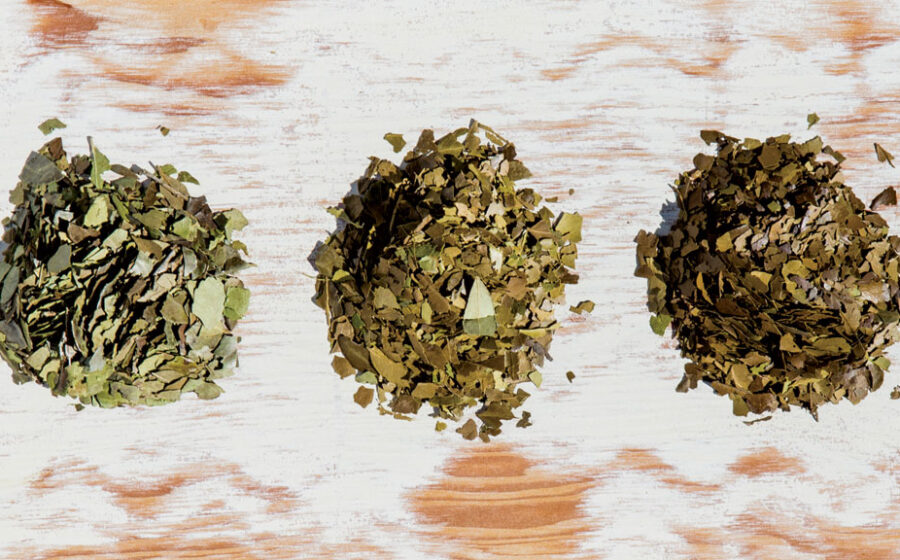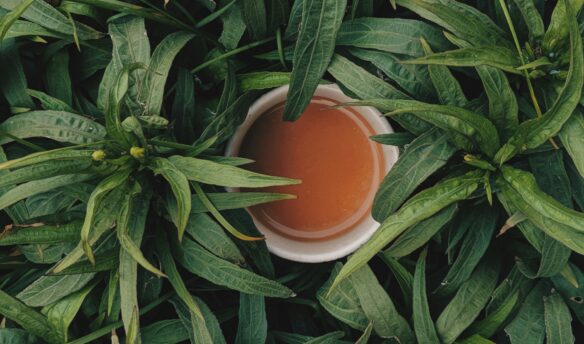[Y]aupon holly first caught our attention when it was one of the only plants to remain thriving after a drought in 2011 on our family’s ranch in Cat Spring, Texas. After learning more about the plant, its ancient history as a drink, and its caffeinated properties, we knew it was something special.
This “brand new” product is a native tisane that’s grown, harvested, and processed entirely in the United States, and it’s the only caffeinated consumable plant north of Central America’s cocoa-filled forests. Yaupon takes its name from the word for small tree in Catawba, a lost Native American language from a tribe that still exists in the Carolinas. Like its South American cousins, guayusa and yerba mate, it grows as an evergreen shrub or small tree, filling the understory of groves of oaks and pines for hundreds of miles inland from the Gulf Coast and even along the Atlantic Coast into southern Virginia. Yaupon boasts a tenacious growth pattern and incredibly resilient root system, which allowed it to survive the drought at Cat Spring. Its brilliant red fruits feed migratory birds, and its waxy green leaves and stems are made into a tisane.
Throughout the South, domesticated cultivars are often used for boxwood-like hedge. Even though it’s a powerful source of energy and antioxidants, yaupon has largely been a forgotten beverage in modern America.
For centuries Native Americans along the Gulf Coast and throughout the Southeast traditionally consumed the prepared leaves as a beverage, both for a daily energy boost and as a ceremonial drink. The “black drink,” as it was called, had been a staple for many tribes. In the past several years, archeologists have tested pottery shards for caffeine markers—looking for traces of yaupon—in both New Mexico and Illinois, far from yaupon’s growing regions, indicating extensive trade of yaupon for the previous millennia. Yaupon had been exported to England and France in the seventeenth century, referenced in many shipping ledgers as “cassina.” However, those importing tea for English colonists increasingly downplayed the native yaupon as a beverage for the working class, and it fell out of widespread use.
Despite being consumed for more than a thousand years, the last two hundred years have lapsed without widespread preparation and enjoyment of yaupon. Like with our company, Cat Spring Tea, most other yaupon producers have only rediscovered the plant recently.
Yaupon is that rare thing: a new taste that comes from a familiar place.
Cultivation, harvesting, preparation, and even the final presentation of packaged yaupon are all a revival of this forgotten resource. Currently wild yaupon is harvested and, using a hybrid of traditional Camellia sinensis and yerba mate processing methods, yaupon leaf is either dried or roasted. Green yaupon is the least oxidized while the dark roast and medium roast black yaupon are more highly oxidized. The difference in preparation methods gives each yaupon a unique flavor profile. The green offers a bright, pleasant tartness with a slight maltiness. The medium-roast black yaupon is characterized by caramel notes, a gentle sweetness, and a clean finish. The dark-roast offers a subtly smoky, complex, earthy taste with a satisfying finish.
With a pleasant full-bodied base, yaupon lends itself to be easily blended with various herbs, fruits, and spices. For blenders, thinking of how you use other ilex species, like yerba mate and the recently popularized guayusa, is a good place to begin with yaupon.
Of particular importance is the opportunity for Cat Spring to create fresh-start job opportunities to members of their local community in Texas. With harvesting, processing, and packaging all done by hand, the yaupon-making process requires a large amount of skilled and unskilled labor. While yaupon grows abundantly in the region, the long neglect of the plant as a food means there’s a lack of knowledge of how to harvest and prepare the leaf. Many Texans consider Yaupon a weed that needs to be cleared, not cultivated.
With a pleasant full-bodied base, yaupon lends itself to be easily blended with various herbs, fruits, and spices.
At Cat Spring, we work with landowners toward land management practices that benefit long term yaupon crop yield. We also train harvesters to comb harvest areas for yaupon with desired quality and characteristics. This activity creates a synergistic result where unproductive land—tracts not supporting cattle, forage, or hay pasture—is redeemed due to the revival of yaupon. Likewise, an area of Texas that offers limited employment or career choice, particularly to individuals who are eager to make a future that looks different from their past, is now ripe with yaupon-harvesting opportunity.
Helping us in this regard are organizations that offer support for individuals fighting poverty, incarceration records, addictions, and other personal obstacles. There is a strong correlation between the rediscovered resource of yaupon and the rediscovered resource of Texans eager to join the workforce.
Yaupon is that rare thing: a new taste that comes from a familiar place. It produces an enjoyable, stimulating, healthful beverage for a marketplace eager for new flavors. Mild and low in tannins, yaupon is enjoyable steeped hot, served over ice, or cold-brewed. Yaupon delivers a great story for informed consumers who are searching for meaningful stories to fuel their purchases. Natural, wild, native yaupon is a sustainable harvest that casts light on both the dignity of a forgotten workforce and the overlooked, historic plant.
—Abianne Falla and JennaDee Detro are the co-founders of Cat Spring Tea in Cat Spring, Texas.















